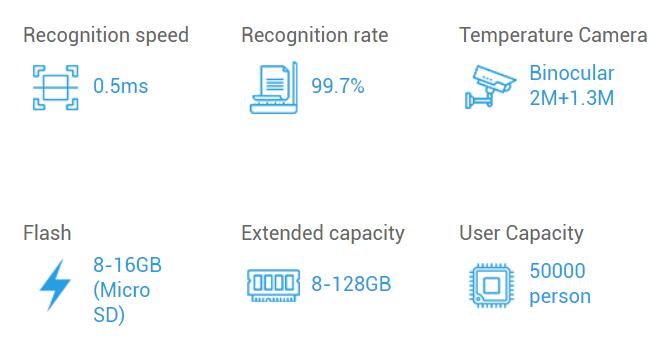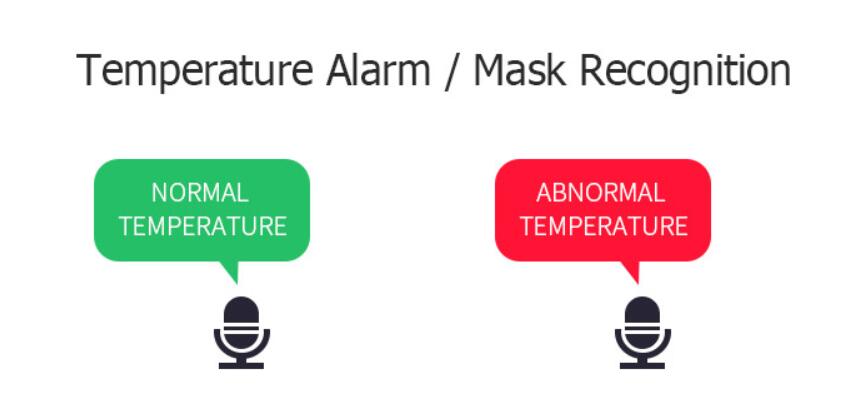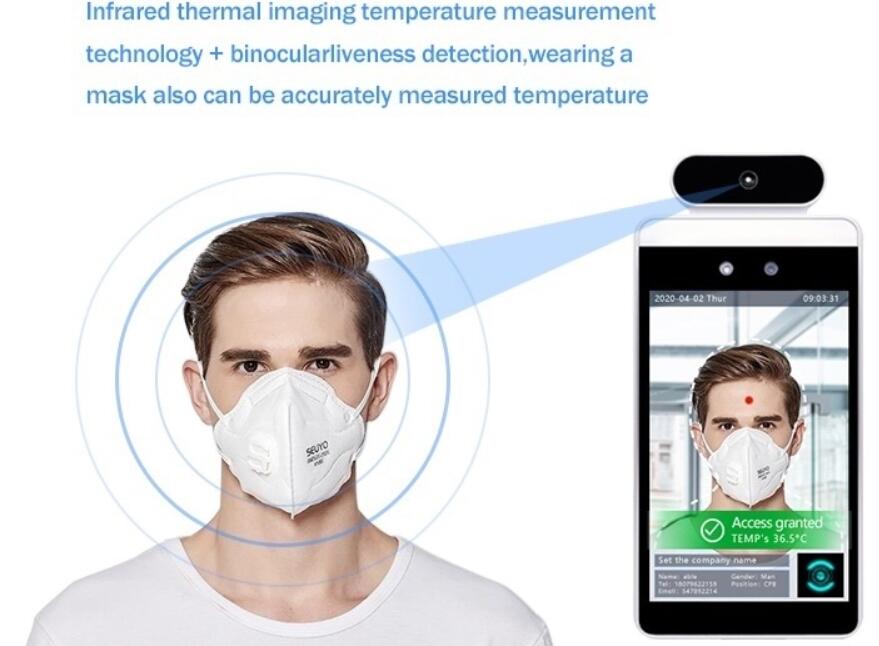The facial recognition’s powerful identification and authentication capabilities make it ideal for two primary applications: first as a security tool, and second as a workforce management solution.
The Touchless, Accurate Credential Solution
Even before the COVID-19 pandemic, the touchless nature of facial recognition as an access credential was gaining traction with physical and cybersecurity professionals. By using an individual’s face as an access control credential, facial recognition eliminates the need and expense of physical cards and proximity devices, or the need to physically enter PIN codes.
but after the COVID-19 pandemic, the face recognition with temperature detections meet the new emerging need to limit physical exposure to germs and viruses and fever.
The COVID-19 pandemic, and hopefully soon to follow post-pandemic world, have surely accelerated the need for highly accurate, cost-efficient, and reliable facial recognition technologies to help get people back to work safely. Selecting the right facial recognition solution for your specific access control and/or workforce management is now more important than ever before, making a little extra due diligence during the evaluation process a smart decision.
Facial Recognition Companies See the Coronavirus as a Business Opportunity
Facial recognition companies are pitching the technology as a sanitary alternative to fingerprint scanners
The Covid-19 crisis enveloping millions of people around the world is also presenting an unlikely business opportunity for one sector of tech: facial recognition technology. it as a method for identifying individuals without the risk of close contact.
Fingerprint scanners, for instance, require that many people touch the same surface, which could potentially spread infection if someone with Covid-19 were to use an unclean scanner. Businesses in India are being directed by police to ditch fingerprint authentication in lieu of facial recognition or ID cards, and the NYPD is pausing its fingerprint entry amid coronavirus concerns. It’s already in use by the Thai government for border control.
Companies are eager to make facial recognition the default form of identification is rushing to fill the void.
In the face of this outbreak, DO RFID group developed a solution for non-contact body temperature measurement plus face recognition
we are launching facial recognition thermometer terminals with temperature-sensing, which allegedly work even if a person is wearing a face mask.
In the face of this outbreak, we have developed a solution for non-contact body temperature measurement plus face recognition in order to meet the rapid need to diagnose the patient and isolate and control the virus in time.
This facial recognition thermometer can not only reduce the risk of cross-infection but also improve traffic efficiency by more than 10 times, which will save time and reduce congestion. It is suitable for government, customs, airports, railway stations, enterprises, schools, communities, and other crowded public places.
Covid-19 has also spurred facial recognition thermometer companies to market facial recognition algorithms that work even when someone is wearing a mask.
facial recognition thermometer is also being used amid the pandemic to determine if people are following local regulations.
Russia is using facial recognition to track those who are leaving their quarantine. One Moscow resident was visited by police after violating his quarantine by taking out the trash, according to the Moscow Times.
In Shanghai, communities are installing facial recognition in residential buildings to reduce contact with shared physical surfaces.
Other residents in China, where facial recognition partnered with temperature sensing has become commonplace.
Facial recognition technology has begun from years ago. Initially plagued with technical challenges and not use widely.
Nowadays, the new advancements in software, specifically in the areas of algorithms, neural networks and deep learning and/or artificial intelligence (AI), have all dramatically improved both the performance and accuracy of facial recognition, further expanding its use for an increasing number of applications.
Let's see the features of the facial recognition thermometer
IDE And Near-Angle LEDs
Most face recognition thermometer terminal employ some form of IR (Infrared) technology to help ensure high visibility by the unit’s image sensor. This often limits where the unit can be installed such as outdoors or near windows due to strong ambient light. More advanced facial recognition readers employ as many as 80 wide-angle near infrared LEDs and 60 narrow-angle near infrared LEDs, allowing the unit to recognize faces even in full daylight and brightly lit environments (not direct sun). This enables installation at indoor locations near windows, lobbies and building entries.
3D Pixel Intensity Distribution Analysis
Another facial recognition reader advancement to look for involves three-dimensional pixel intensity analysis. Ambient lighting contains ultraviolet rays which can negate near infrared LED lighting, and can also cast shadows making it difficult for a facial recognition reader to pinpoint the facial recognition points required for identification and authentication. Three-dimensional pixel intensity distribution analysis minimizes the effects of ambient light when acquiring facial images by minimizing lighting contrasts. As a result, it is easier for the algorithm to recognize the shape of the face, enabling it to extract more facial features and create higher quality face templates, which are critical for accurate facial recognition.
Functional Ergonomics
The angle and position of a facial recognition reader directly impact the performance of the unit. Facial recognition readers with different viewing angles for built-in visual and infrared cameras allows users to stand at positions that are most suitable for facial recognition with little or no effort of contortions. This results in a faster, more comfortable, and convenient user experience.
High Performance Processing
Like any intelligent edge device, the performance of a facial recognition solution is directly reliant on its processing power. New advanced facial recognition readers deliver exceptional performance by employing enhanced face template extraction technology combined with a powerful processor. For example, a facial recognition reader with a 1.4 GHz quad-core processor can perform up to 3,000 facial database matches (1:N) within one second. More advanced solutions also feature Group Matching functionality capable of executing up to 30,000 matches within one second.
Live Face Detection
It is most important that the facial recognition readers you evaluate are capable of analyzing faces in real time to maintain fluid entry/egress even during high volumes of employee traffic. Hardware-dependent live face detection systems employing technologies such as facial thermogram recognition and facial vein recognition require expensive hardware components, provide less accurate matches and slower authentication performance, which is counterintuitive for mainstream access control and workforce management applications.
Dual Authentication For Added Security
Although the use of an advanced facial recognition reader provides the convenience, health benefits and cost-savings of touchless identification and authentication, there are many applications where more than one credential may be necessary to ensure the highest levels of security. Advanced facial recognition readers with multimodal, multifactor credentialing capabilities provide this added security benefit. For example, facial recognition readers that support multiple RFID proximity devices supporting 125 kHz and 13.56 MHz provide varying degrees of protection and greater implementation versatility.
Videophone Or Intercom Capabilities
face recognition thermometer with multifunctionality can solve several challenges with one solution
facial recognition thermometer with multifunctionality can solve several challenges with one solution. A perfect example includes devices with SIP (session initiation protocol) videophone capabilities which effectively eliminate the need and associated expense of installing separate intercom devices while adding another layer of security to one’s facility.



255.jpg)
